Process of preparing titanates
- Summary
- Abstract
- Description
- Claims
- Application Information
AI Technical Summary
Benefits of technology
Problems solved by technology
Method used
Image
Examples
example 1
[0078]The preparation of titanium dioxide by the sulphate process was initiated by reacting ilmenite concentrate with sulphuric acid. The solid reaction cake thus formed was dissolved by means of water and waste acids. Impurities were removed and iron sulphate was crystallized out. The titanium-containing solution was concentrated and the titanium dioxide hydrate was precipitated by hydrolysis. This precipitation material was washed in several stages to render it free of salts.
[0079]About 10 tonnes of washed titanium dioxide hydrate precipitation material was taken, expressed as TiO2, and elutriated with water to a density of 300-400 g / l, the aim being 350 g / l. The slurry thus provided was rendered highly alkaline, pH>11, by adding about 15 tonnes of NaOH as an NaOH solution at 60° C., its concentration being 700 g / l. The temperature of the slurry was raised to 95° C. and the slurry was agitated at this temperature for two hours. During the treatment, the titanium dioxide hydrate ma...
example 2
[0084]The samples were prepared as in Example 1; however, with the distinction that the molar ratio Ba / Ti of the barium hydroxide addition was 1.2.
[0085]According to the x-ray diffraction analysis, crystalline BaTiO3 was formed in all of the samples, as shown in Table 3. Neither peaks of sodium titanate that are due to the starting material, nor peaks of titanium dioxide occur in the samples. Measured from the broadening of the x-ray diffraction peaks, the crystal size is below 100 nm. The molar ratio of barium-titanium was 0.98 and the analyses show that the sodium content remained at 0.011% by weight.
TABLE 3Crystal size fromthe broadeningTBa:Tiof the peak [nm]BETSample[° C.]mol~31°~39°~45°[m2 / g]2.11100.9833422936.12.245035453130.52.375047633410.8
[0086]The x-ray diffractograms of the dried sample 2.1 and calcined samples 2.2 and 2.3 are shown in FIG. 3. In the figures, the y axis is an intensity reading, as is well known, and the x axis is degrees two-theta.
example 3
[0087]The samples were prepared as in Example 1; however, with the distinction that the molar ratio Ba / Ti of the barium hydroxide addition was 1.4.
[0088]The mixture was allowed to react at 75° C. for 180 minutes under continuous agitation. The precipitate was filtered and washed with plenty of warm water. The sample was dried in a vertical drying furnace at a temperature of 110° C., until dry. The sample was divided into four parts, of which one part was not calcined and the other three were calcined at temperatures of 750° C., 850° C. and 950° C.
[0089]According to the x-ray diffraction analysis, crystalline BaTiO3 was formed in all the samples, as shown in Table 4. Neither peaks of sodium titanate that were due to the starting material, nor peaks of titanium dioxide occur in the samples. Measured from the broadening of the x-ray diffraction peak, the crystal size is below 100 nm. The molar ratio of barium-titanium is 0.99 and the analyses show that the sodium content remains at 0.0...
PUM
| Property | Measurement | Unit |
|---|---|---|
| Temperature | aaaaa | aaaaa |
| Temperature | aaaaa | aaaaa |
| Temperature | aaaaa | aaaaa |
Abstract
Description
Claims
Application Information
 Login to View More
Login to View More - R&D
- Intellectual Property
- Life Sciences
- Materials
- Tech Scout
- Unparalleled Data Quality
- Higher Quality Content
- 60% Fewer Hallucinations
Browse by: Latest US Patents, China's latest patents, Technical Efficacy Thesaurus, Application Domain, Technology Topic, Popular Technical Reports.
© 2025 PatSnap. All rights reserved.Legal|Privacy policy|Modern Slavery Act Transparency Statement|Sitemap|About US| Contact US: help@patsnap.com



